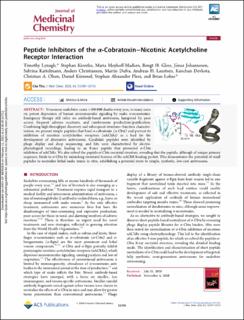Peptide Inhibitors of the α‑Cobratoxin−Nicotinic Acetylcholine Receptor Interaction
Lynagh, Timothy; Kiontke, Stephan; Meyhoff-Madsen, Maria; Gless, Bengt H.; Johannesen, Jónas; Kattelmann, Sabrina; Christiansen, Anders; Dufva, Martin; Laustsen, Andreas H.; Devkota, Kanchan; Olsen, Christian A.; Kümmel, Daniel; Pless, Stephan Alexander; Lohse, Brian
Journal article, Peer reviewed
Published version

Åpne
Permanent lenke
https://hdl.handle.net/11250/2760985Utgivelsesdato
2020Metadata
Vis full innførselSamlinger
Originalversjon
Journal of Medicinal Chemistry. 2020, 63 (22), 13709-13718. 10.1021/acs.jmedchem.0c01202Sammendrag
Venomous snakebites cause >100 000 deaths every year, in many cases via potent depression of human neuromuscular signaling by snake α-neurotoxins. Emergency therapy still relies on antibody-based antivenom, hampered by poor access, frequent adverse reactions, and cumbersome production/purification. Combining high-throughput discovery and subsequent structure–function characterization, we present simple peptides that bind α-cobratoxin (α-Cbtx) and prevent its inhibition of nicotinic acetylcholine receptors (nAChRs) as a lead for the development of alternative antivenoms. Candidate peptides were identified by phage display and deep sequencing, and hits were characterized by electrophysiological recordings, leading to an 8-mer peptide that prevented α-Cbtx inhibition of nAChRs. We also solved the peptide:α-Cbtx cocrystal structure, revealing that the peptide, although of unique primary sequence, binds to α-Cbtx by mimicking structural features of the nAChR binding pocket. This demonstrates the potential of small peptides to neutralize lethal snake toxins in vitro, establishing a potential route to simple, synthetic, low-cost antivenoms.
Beskrivelse
Copyright 2020 American Chemical Society
